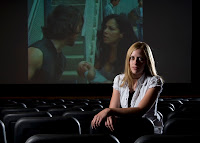I started off this semester as a disillusioned
Internet consumer. I felt guilty about the time I had “wasted” (blog
surfing, Facebook stalking, news-article-comment-reading) online over the years
and I blamed new media for my own lack of productivity. I looked forward to
this “Digital Culture” class by virtue of its seeming departure from the norm
(as far as English classes go, anyway!) but I had no idea then of its potential
to change how I view our world.
 |
| In my former life...{image from here} |
This semester, through a combination
of the various exercises we’ve been assigned to do as well as my self-motivated
learning, I’ve come to understand the key I was missing in my prior identity in
the digital world: the difference between acting and being acted upon. In other
words, I’ve learned how to balance potentially passive (and often “pointless”) consuming
with proactive creating and meaningful connecting. I needed the 3 C’s, and I’m
well on my way to making them a part of my digital life from here on out.
My self-directed
learning has been characterized by reading (consuming), writing (creating), and
conversing with others (connecting) on a variety of topics in digital culture. I
have collaborated with those in my own project group as well as others in the
class throughout the semester. Here are some highlights for my “semester in
review.”
On my blog, I wrote about “Slaughterhouse-Five”
after reading, discussing it in my ENG 365 class, and analyzing its themes in
light of digital culture topics we had briefly touched on in class and that I
had considered myself (1
& 2).
I reviewed David Weinberger’s “Too
Big to Know” and shared my learning about collaboration and crowdsourcing. I
attended the Mormon Media Conference and reflected on concepts we discussed
during class time, such as the draws and dangers of virtual worlds (1
& 2).
I also read about some of Dr. Coyne’s research studies (1 & 2 published, others
under review). Next on my list of sources to consult? Zimmerman’s (2007) study
on “Associations between media viewing and language development in children
under two years” as I prepare to parent an “under-two-year-old” starting at the
end of January!
On G+, I did a lot of interacting
with my classmates. I enjoyed looking into links and comments posted by
classmates as well as sharing my own findings and reflections. Some of the interesting
articles and links I shared included a robot
boss being developed and with implications for the workplace, a moving 9/11
photojournalism curation, and a successful blogger’s extensive advice for
those wanting to run a
successful online business from home. Additionally, I shared my research
about video games with the LBP group on G+ (Video games good
for girls & Good
gaming for your kids—also Badges,
video games, & gamification that I shared with the Badgers, too). Other
contributions I made to group projects included writing a chapter segment for CCC’s
novel (as well as promoting their project on G+, encouraging other classmates
to do the same) as well as submitting a poem to Menagerie.
Those who I felt contributed most to
my learning? Besides my digisweethomies (who have not only helped me learn but
who I also look forward to keeping in touch with beyond this class!), the
classmates who have most inspired me with their contributions to class discussions
on and offline are Ellis Dyck, Shelby Boyer, and Casey Deans. I found that
their respective choices of content as well as their engaging writing styles set
them apart. Way to go, guys!
I think the most important
self-directed learning I did was in my conversations
with my mom about her views and concerns about the digital world. I felt that
we were able to learn from each other as we discussed important issues that
relate particularly to our family’s situation. In my group project, I was
especially concerned with the importance of connecting generations, and did
self-directed learning in that theme to prepare our materials for our webinar
and youtube playlist (here’s my especially
for grandparents post).
As far as group collaboration goes, I tried my best to help my group in delegating
responsibilities and making sure we recorded those responsibilities and were
regularly communicating outside of class. With Allie, I “rallied the troops” as
we established ourselves as a group and decided on the direction we wanted to
go. I helped in the processes of gathering social proof, creating our survey, putting
together our proposal video, testing the webinar software, compiling our
presentation materials, and curating our youtube playlist. It’s been an awesome
journey, and I wish everyone the best in the future! Thanks for a wonderful
semester.














